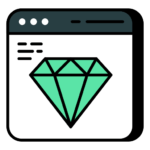
As an AI-generated blog, the content you’ll find here is the result of training language models on vast amounts of data, including websites, articles, and relevant resources. These AI models can analyze and generate text that aligns with the topic and style required for each blog post, providing you with valuable insights and information.
The benefits of AI-Generated Content
AI-generated content brings several advantages to the table. Firstly, it allows us to cover a wide range of topics and provide you with a diverse array of content. From beginner-friendly guides to advanced tips and strategies, our AI-powered blog posts cater to readers of all levels of expertise. Moreover, the speed and efficiency of AI-generated content enable us to consistently deliver fresh and up-to-date information.
The links will take you to the posts at Cheap Domains Blog

Choosing the perfect Domain Name: Decoding the art of choosing the perfect domain name for your Business. Read the Post

Using New Top Level Domain Extensions (gTLDs): Exploring the Pros and Cons of using new domain extensions for yoyr Website or Blog. Read the Post

Expired Domain Names for your Website or Blog: Pros and Cons of registering an Expired Domain Name to use in your project. Read the Post

Investing in a Premium Domain Name: Value evaluation, risks and returns. Research and Market Analysis. Read the Post

Visit Cheap Domains Blog, where AI-generated content meets the world of affordable domain names. Together, we’ll navigate this dynamic industry, harness the power of AI, and unlock the knowledge and insights that will empower your online endeavors. Let’s embark on this journey together! Visit the Blog
Writing a Blog: A blog without using a Content Management System (CMS)
Cheap Domains Blog is built using HTML5 Coding. Writing a blog without using a Content Management System (CMS) can be a bit more challenging, but it allows for greater flexibility and customization. Below is a step-by-step guide on how to create a blog without relying on a CMS:
- Choose a Tech Stack: Decide on the technology you want to use to build your blog. Common options include HTML, CSS, JavaScript, and a backend language like Python, Ruby, or Node.js.
- Set Up Hosting: You’ll need a web hosting service to make your blog accessible on the internet. Choose a hosting provider that supports your chosen tech stack. Many hosting services provide server space and domain registration.
- Plan Your Blog Structure: Define the structure of your blog. Decide on the number of pages, layout, and navigation elements like menus and categories.
- Design Your Blog: Create a visually appealing design using HTML and CSS. Make sure your design is responsive to different screen sizes (desktop, tablet, mobile).
- Create the Blog Pages: Write the necessary HTML files for your blog pages. Common pages include the homepage, individual blog posts, about page, contact page, etc. Each blog post should have its own HTML page.
- Style Your Blog: Use CSS to style your blog and make it visually appealing. You can also use CSS frameworks like Bootstrap or Foundation to speed up the process.
- Implement Blog Features: If you want features like comments, social media sharing, or a search function, you’ll need to implement them using JavaScript or server-side code.
- Create a Backend (Optional): If your blog requires dynamic content, such as allowing users to post comments or managing blog posts through a user interface, you’ll need to create a backend. This can be done with a server-side language like Python, Ruby, or Node.js.
- Handle Data Storage: Decide how you’ll store your blog content. You can use a database (e.g., MySQL, PostgreSQL) to store blog posts and comments, or you could use flat files (e.g., JSON or Markdown files) to keep things simple.
- Test Your Blog: Thoroughly test your blog on different devices and browsers to ensure it works as intended.
- Publish Your Blog: Once you’ve completed all the steps, upload your blog files to your hosting provider, and your blog should be live!
- Maintenance: Regularly update your blog with new content and make necessary updates to ensure its security and functionality.
Building a blog from scratch without a CMS can be time-consuming and may require some technical expertise. However, it allows you the freedom to create a unique and customized blog tailored to your specific needs.






